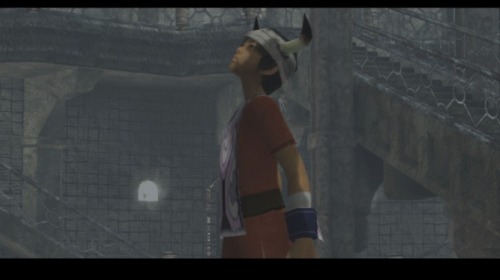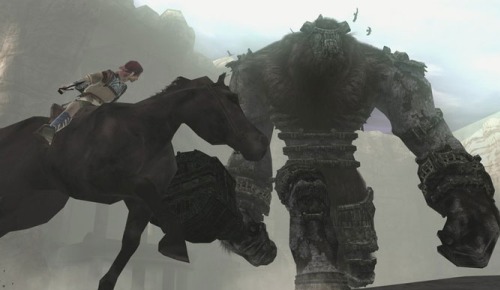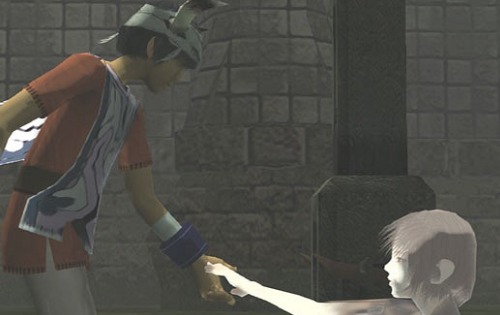Team Ico is responsible for two of the most acclaimed games of all time. Now both those games are together in one affordable HD collection for the PS3. I played just a bit of Ico in the PS2 days and managed to miss out on Shadow of the Colossus entirely, but now that both have emerged in this new collection, I am eager to take the plunge and find out if these two games still live up to the hype that they have left in their wake.
Ico
The first game is the one from which the developers get their name. Ico is the story of a boy who is brought to an island as a sacrifice and stumbles upon a girl in the ruins of the island. Together, they must solve puzzles and fend off the shadowy creatures that seek to capture the girl, known as Yorda, and somehow find their way off the island. There is more to the story than this, but I feel like part of the joy of Ico is in slowly unraveling the mysteries of the castle. To spoil any further would be to rob you of that.
The main components of the game are the combat, puzzles and platforming, which all fuse together to make the game rise above the sum of its parts. The combat is very basic. Hit the Square button to whack away at the shadow monsters that are trying to take Yorda away from you. Pretty basic and nothing to write home about. But when combined with the urgency of solving a puzzle and getting back to Yorda before the creatures appear and whisk her away, you will be grateful for that simplicity. I can’t tell you how many times I saved Yorda with a last second strike that left my heart pounding. The developers could have chosen to make the combat more complicated, but that would have actually done a disservice to the game. Sometimes, less is more and Ico is shining example of that.
The puzzles you come across are simple at first and grow more and more complex until you start to think that you are in over your head. Thankfully, there are no sly tricks that make any of them feel cheap. Everything you need is given to you and the lessons you learn as you play are then brought into future puzzles in new ways that keep the game constantly feeling fresh, even if they are sometimes just new twists on box moving puzzles. The platforming is basic as well and Ico does control a little clunky at times, but you aren’t doing any Super Mario moves here. Think something more like Prince of Persia and you are on the right track. Dragging Yorda around, fighting the monsters off and solving the puzzles while uncovering a story that just might move you to tears is enough to ensure that Ico lives up to the decade-long hype.
Shadow of the Colossus
At least it was until I played Shadow of the Colossus. Being a completely different game and still building on some of the themes from Ico, SotC tells the story of a man who is trying to revive a girl who has died. The way in which he goes about doing this is summoning a (clearly) demonic spirit that tells him to slay 16 Colossi that are wandering the world. The Colossi are huge , ranging from a bird with a wingspan that takes about a minute to walk across to a enormous turtle-like creature that seems as tall as a mountain. Your goal is to climb atop these majestic creatures, find their weak spots and go all stabby stabby on them until they crumple to the earth with a guilt-inducing death rattle.
To do this, you enlist the help of your faithful horse, Agro. While riding Agro, you can point your sword to the sky and a beam of light will reflect in the direction of the next Colossi that you are attempting to kill. Once you find it, the music quickens, raising the tension. You can climb on the Colossi using their fur, grip on to their armor or shells and run across their backs and heads, all the while frantically searching for a symbol that appears on their body which signifies their vulnerable point. Once you find it, you have to withstand the monster trying to shake you off long enough to raise your sword and strike down as hard as you can. This is made difficult by the stamina meter that limits how long you can maintain your grip. If you fall off, you will be forced to climb your way back and try again.
There are no other enemies in the game other than the Colossi. You find one, kill it and are returned to the hub. From there, you find the next one. Rinse, repeat. This may sound boring, but it never is. Each Colossi is a spectacle, a wonder and a giant puzzle that is intent on killing you, all rolled into one. Some days I played and could only kill 1 Colossi. On a good weekend, I killed 8, which should clue you in on how addictive the game can be. Something weird happened as I was playing. though: I felt sadness at killing the Colossi. Even if I was supremely frustrated and cursing the furry bastard to high heaven, when the dealthblow was struck and the creature fell, I felt terrible. Was it worth it, killing 16 innocent creatures to save 1 girl? I have heard stories of how some people stopped playing the game because of their guilt. While I wouldn’t go that far, I do see how that can happen. Shadow of the Colossi starts off as an epic adventure and leaves you gut-punched with emotions that you didn’t see coming. These emotions are genuine because they come from you, from your perspective on the story, which kind of blew me away.
Legacy
These games are several years old and came out in the previous generation. So why are they still more artful, more emotionally resonant and more original than many of the games we play right now? Sure, every now and then a game comes along that really blows us away, but it happens few and far between. Here we have two of best games of the last generation, made by the same team and in one place. If you pick up this collection, you will be shell-shocked that lightning strikes twice on the same disc. Even if some of the controls and mechanics are clearly outdated, the graphics are beautiful and the games themselves are stellar. Not once did I think that I was playing a game that was outdated. These two games stand the test of time and should be experienced by every gamer out there.





